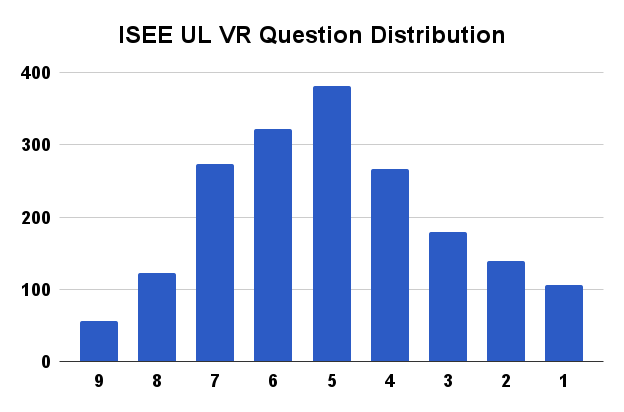Over the past week, our team has been furiously implementing a major upgrade to Piqosity’s back-end statistics. All practice questions—from standardized tests like the ISEE and ACT to our core academic courses in English and math—are now peer normed for difficulty.
Previously a question’s author manually selected a difficulty of easy, medium, or hard. These selections were generally precise because Piqosity’s first party writers follow detailed specifications especially when writing prep questions for a standardized test. However, the only way to truly gauge a question’s difficulty is to gather data from real students.
Unsurprisingly given our population of human children, we found that our data is generally “normal”—meaning that the accuracy response results are evenly distributed along a Gaussian / bell curve where the mean and median are the same—and in-line with the standardized tests for which we are preparing students. As such, we’re able to divide this dataset into 9 evenly sized slices of 1/2 standard deviation where a 1 represents the easiest questions, 5 the average difficulty questions, and 9 the most challenging questions.
 For example, in our ISEE Upper Level course, there are 1848 Verbal Reasoning questions which are answered correctly on average 49% of the time (first attempt, current 8th graders) with the data fairly evenly distributed around a median of 48%.
For example, in our ISEE Upper Level course, there are 1848 Verbal Reasoning questions which are answered correctly on average 49% of the time (first attempt, current 8th graders) with the data fairly evenly distributed around a median of 48%.
- The synonym question, “idolize” has been answered correctly 93% of the time, which earns it a dynamic difficulty of “easy, 1.”
- The synonym question “antediluvian” has been answered correctly 49% of the time, which makes it a solidly “medium, 5” question.
- The synonym question, “sanguine” has only been answered correctly 19% of the time and is therefore a “hard, 9” question.
More Precise Score Estimates
For our standardized test prep courses for the ISEE, ACT, and SAT, parents and educators always ask the question, “how do Piqosity’s questions compare to the actual test in difficulty?” This question is now statistically answered by the data itself–Piqosity’s mean and median are very similar to the actual standardized tests.
However the students who choose to use Piqosity, our norm group, is smaller than that of an actual ACT, SAT, or ISEE. Therefore Piqosity’s estimated test scores will usually be conservative by up to 1 standard deviation. For example, if Piqosity says that a student will likely score a 5 on the ISEE, there’s a good chance that student will actually score a 6 when test-day conditions are similar.
More Personalized Practice
Dividing our question sets into a minimum of 9 levels of difficulty allows us to more precisely tailor question delivery to each student depending on where they are in their learning journey. We are currently preparing a complete overhaul of our Personalized Practice feature that will enable new ways of practicing:
- Adaptive Mode – Question difficulty increases with correct responses and decreases with incorrect responses
- Streak Mode – Questions gradually increase in difficulty until students start making mistakes
Low Stakes, High Precision Assessments
Every question on Piqosity is now peer-normed, which includes our rapidly growing library (6 new courses in the last quarter of 2021 alone) of content for core academic courses in math and English. This means that every type of practice that students work on Piqosity—from in-class assignments to after school enrichment—is automatically scored relative to all users on the Piqosity platform, which includes students from across the United States in different schools and learning environments.
We envision a future where high-stakes testing is therefore replaced with continuous, low-stakes, every day assessments that enable educators and parents to better understand and personalize their child’s learning journey.


